Economics Assignment: CX552001, Business and Market Analysis
VerifiedAdded on 2023/06/10
|14
|1534
|241
Homework Assignment
AI Summary
This economics assignment solution for the CX552001 course in June 2018 covers several key economic concepts. Section A focuses on business decision-making, starting with a cost analysis of a t-shirt manufacturing business, requiring the completion of a cost table and the drawing of AC, MC, AVC, and AFC curves. The assignment then analyzes different market structures, including monopolistic competition and natural monopolies, providing justifications for each. It also examines the conditions for a perfectly competitive market and applies economic principles to real-world scenarios. Section B explores allocative efficiency, including its conditions and applications to public goods and government interventions. It analyzes the impact of taxes and government decisions on market outcomes. Section C delves into the circular flow model, identifying different components and their impacts on national income. It also includes calculations of the Consumer Price Index (CPI), nominal GDP, and economic growth, along with a comparison of nominal and per capita GDP. The assignment demonstrates an understanding of economic concepts and their application to real-world business and policy decisions.
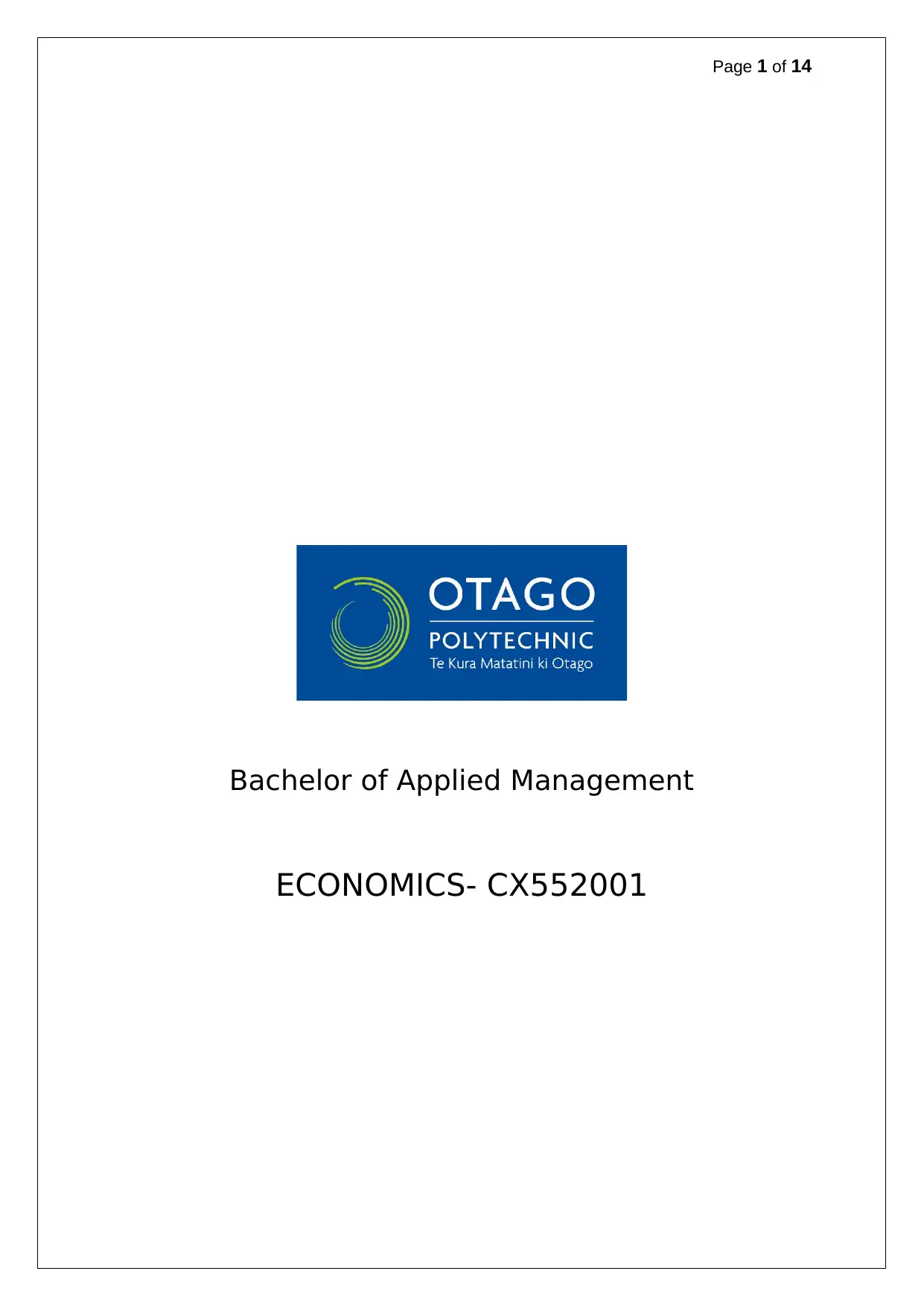
Page 1 of 14
Bachelor of Applied Management
ECONOMICS- CX552001
Bachelor of Applied Management
ECONOMICS- CX552001
Paraphrase This Document
Need a fresh take? Get an instant paraphrase of this document with our AI Paraphraser
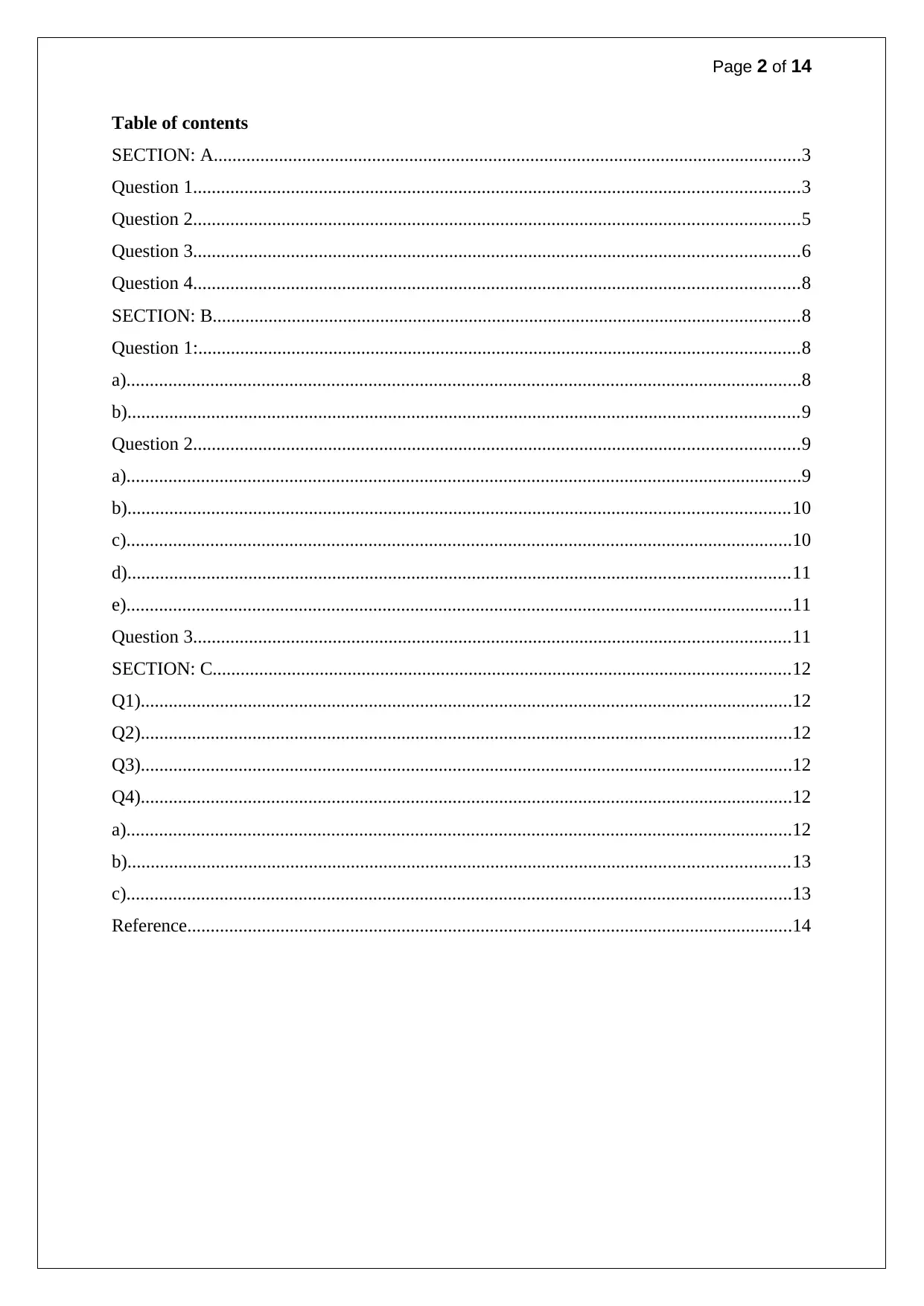
Page 2 of 14
Table of contents
SECTION: A..............................................................................................................................3
Question 1..................................................................................................................................3
Question 2..................................................................................................................................5
Question 3..................................................................................................................................6
Question 4..................................................................................................................................8
SECTION: B..............................................................................................................................8
Question 1:.................................................................................................................................8
a).................................................................................................................................................8
b)................................................................................................................................................9
Question 2..................................................................................................................................9
a).................................................................................................................................................9
b)..............................................................................................................................................10
c)...............................................................................................................................................10
d)..............................................................................................................................................11
e)...............................................................................................................................................11
Question 3................................................................................................................................11
SECTION: C............................................................................................................................12
Q1)............................................................................................................................................12
Q2)............................................................................................................................................12
Q3)............................................................................................................................................12
Q4)............................................................................................................................................12
a)...............................................................................................................................................12
b)..............................................................................................................................................13
c)...............................................................................................................................................13
Reference..................................................................................................................................14
Table of contents
SECTION: A..............................................................................................................................3
Question 1..................................................................................................................................3
Question 2..................................................................................................................................5
Question 3..................................................................................................................................6
Question 4..................................................................................................................................8
SECTION: B..............................................................................................................................8
Question 1:.................................................................................................................................8
a).................................................................................................................................................8
b)................................................................................................................................................9
Question 2..................................................................................................................................9
a).................................................................................................................................................9
b)..............................................................................................................................................10
c)...............................................................................................................................................10
d)..............................................................................................................................................11
e)...............................................................................................................................................11
Question 3................................................................................................................................11
SECTION: C............................................................................................................................12
Q1)............................................................................................................................................12
Q2)............................................................................................................................................12
Q3)............................................................................................................................................12
Q4)............................................................................................................................................12
a)...............................................................................................................................................12
b)..............................................................................................................................................13
c)...............................................................................................................................................13
Reference..................................................................................................................................14
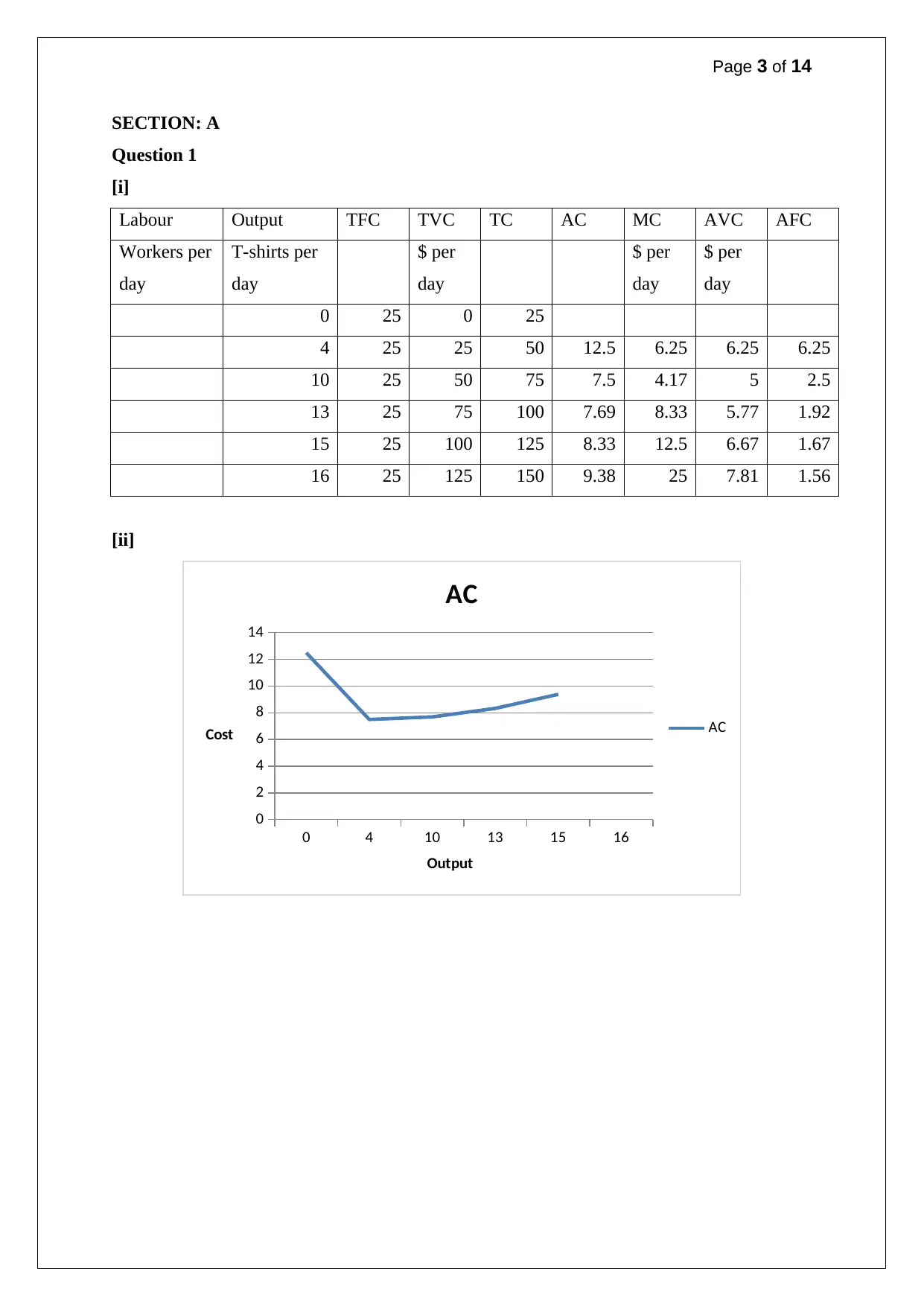
Page 3 of 14
SECTION: A
Question 1
[i]
Labour Output TFC TVC TC AC MC AVC AFC
Workers per
day
T-shirts per
day
$ per
day
$ per
day
$ per
day
0 25 0 25
4 25 25 50 12.5 6.25 6.25 6.25
10 25 50 75 7.5 4.17 5 2.5
13 25 75 100 7.69 8.33 5.77 1.92
15 25 100 125 8.33 12.5 6.67 1.67
16 25 125 150 9.38 25 7.81 1.56
[ii]
0 4 10 13 15 16
0
2
4
6
8
10
12
14
AC
AC
Output
Cost
SECTION: A
Question 1
[i]
Labour Output TFC TVC TC AC MC AVC AFC
Workers per
day
T-shirts per
day
$ per
day
$ per
day
$ per
day
0 25 0 25
4 25 25 50 12.5 6.25 6.25 6.25
10 25 50 75 7.5 4.17 5 2.5
13 25 75 100 7.69 8.33 5.77 1.92
15 25 100 125 8.33 12.5 6.67 1.67
16 25 125 150 9.38 25 7.81 1.56
[ii]
0 4 10 13 15 16
0
2
4
6
8
10
12
14
AC
AC
Output
Cost
⊘ This is a preview!⊘
Do you want full access?
Subscribe today to unlock all pages.

Trusted by 1+ million students worldwide
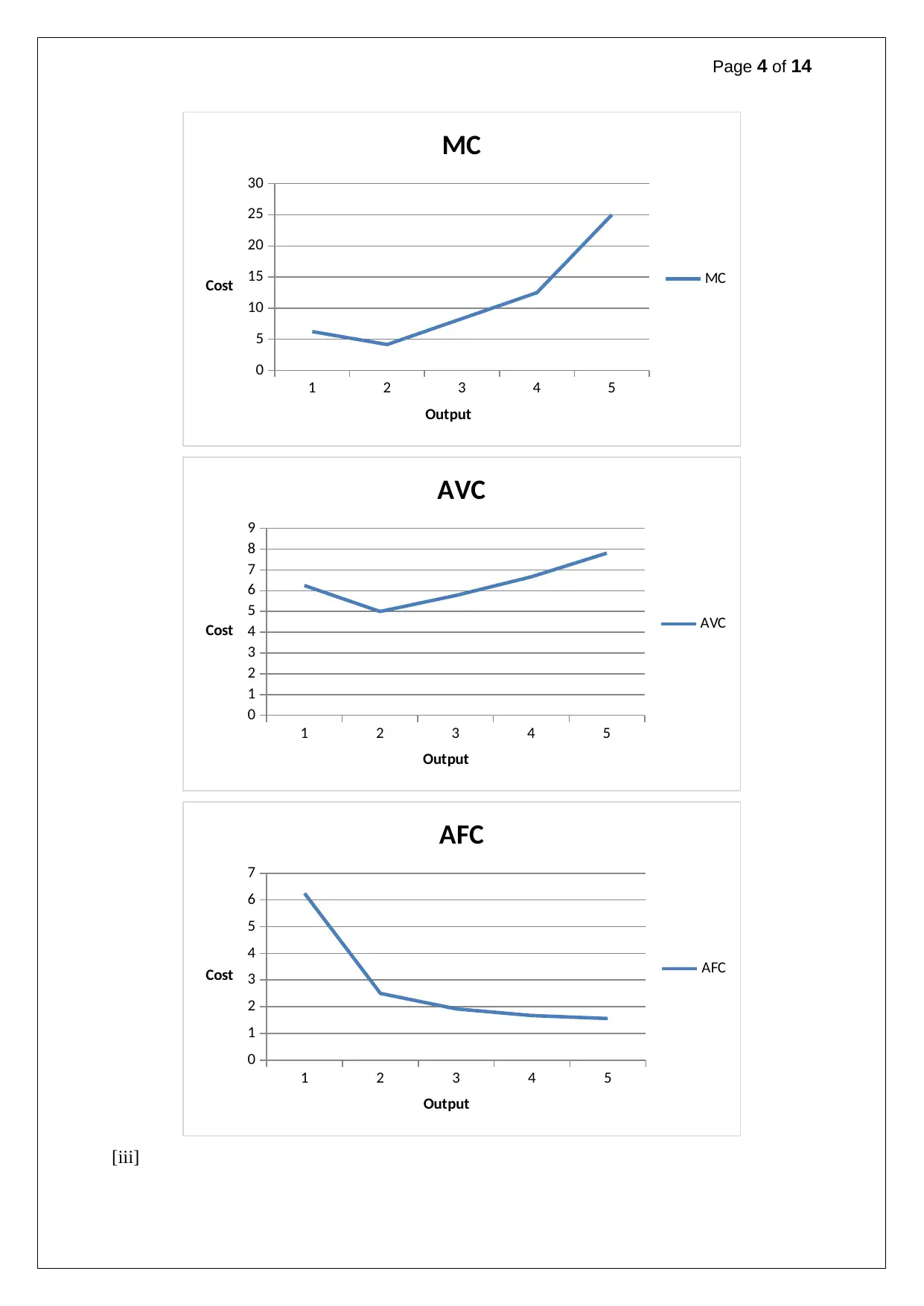
Page 4 of 14
1 2 3 4 5
0
5
10
15
20
25
30
MC
MC
Output
Cost
1 2 3 4 5
0
1
2
3
4
5
6
7
8
9
AVC
AVC
Output
Cost
1 2 3 4 5
0
1
2
3
4
5
6
7
AFC
AFC
Output
Cost
[iii]
1 2 3 4 5
0
5
10
15
20
25
30
MC
MC
Output
Cost
1 2 3 4 5
0
1
2
3
4
5
6
7
8
9
AVC
AVC
Output
Cost
1 2 3 4 5
0
1
2
3
4
5
6
7
AFC
AFC
Output
Cost
[iii]
Paraphrase This Document
Need a fresh take? Get an instant paraphrase of this document with our AI Paraphraser
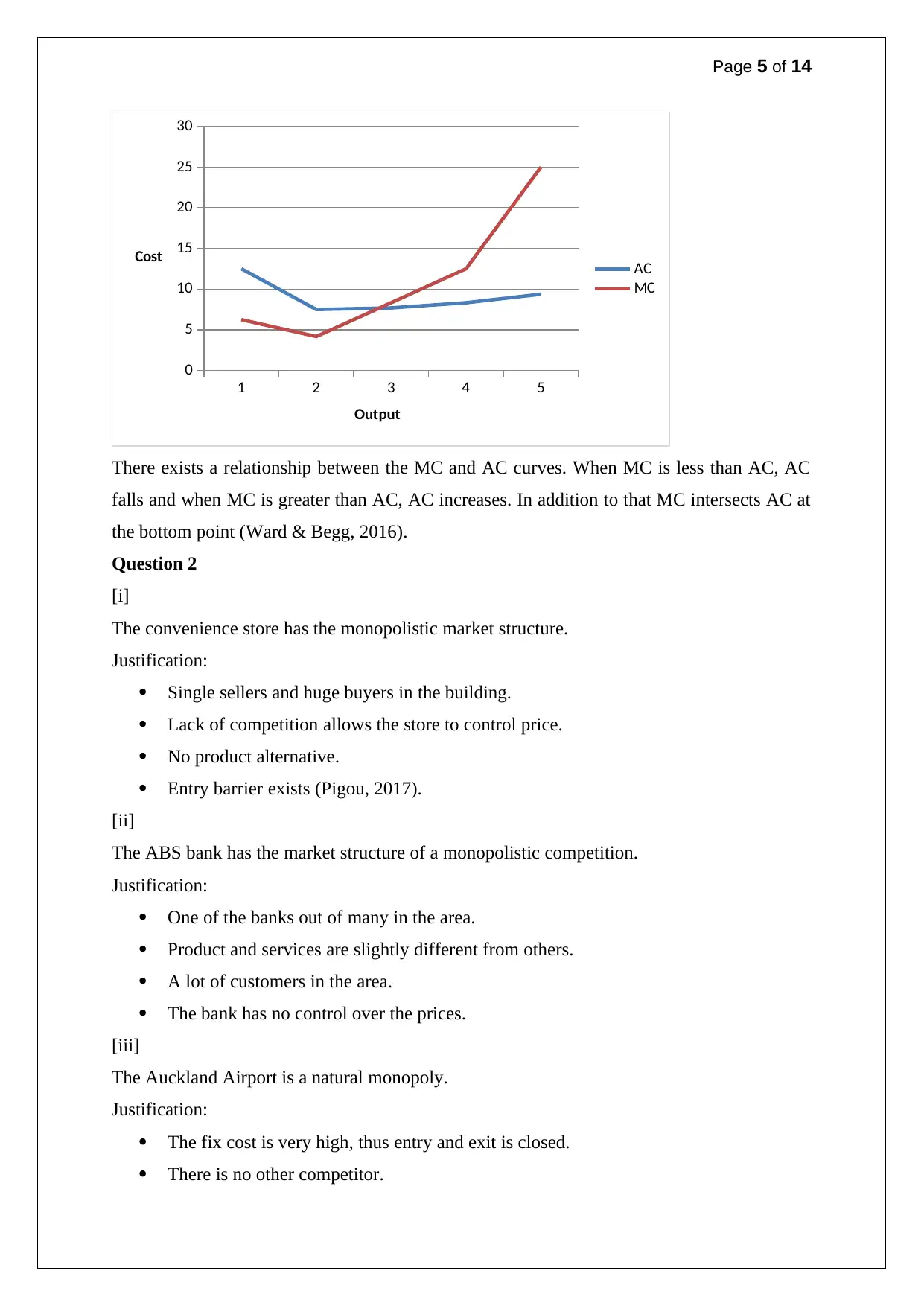
Page 5 of 14
1 2 3 4 5
0
5
10
15
20
25
30
AC
MC
Output
Cost
There exists a relationship between the MC and AC curves. When MC is less than AC, AC
falls and when MC is greater than AC, AC increases. In addition to that MC intersects AC at
the bottom point (Ward & Begg, 2016).
Question 2
[i]
The convenience store has the monopolistic market structure.
Justification:
Single sellers and huge buyers in the building.
Lack of competition allows the store to control price.
No product alternative.
Entry barrier exists (Pigou, 2017).
[ii]
The ABS bank has the market structure of a monopolistic competition.
Justification:
One of the banks out of many in the area.
Product and services are slightly different from others.
A lot of customers in the area.
The bank has no control over the prices.
[iii]
The Auckland Airport is a natural monopoly.
Justification:
The fix cost is very high, thus entry and exit is closed.
There is no other competitor.
1 2 3 4 5
0
5
10
15
20
25
30
AC
MC
Output
Cost
There exists a relationship between the MC and AC curves. When MC is less than AC, AC
falls and when MC is greater than AC, AC increases. In addition to that MC intersects AC at
the bottom point (Ward & Begg, 2016).
Question 2
[i]
The convenience store has the monopolistic market structure.
Justification:
Single sellers and huge buyers in the building.
Lack of competition allows the store to control price.
No product alternative.
Entry barrier exists (Pigou, 2017).
[ii]
The ABS bank has the market structure of a monopolistic competition.
Justification:
One of the banks out of many in the area.
Product and services are slightly different from others.
A lot of customers in the area.
The bank has no control over the prices.
[iii]
The Auckland Airport is a natural monopoly.
Justification:
The fix cost is very high, thus entry and exit is closed.
There is no other competitor.
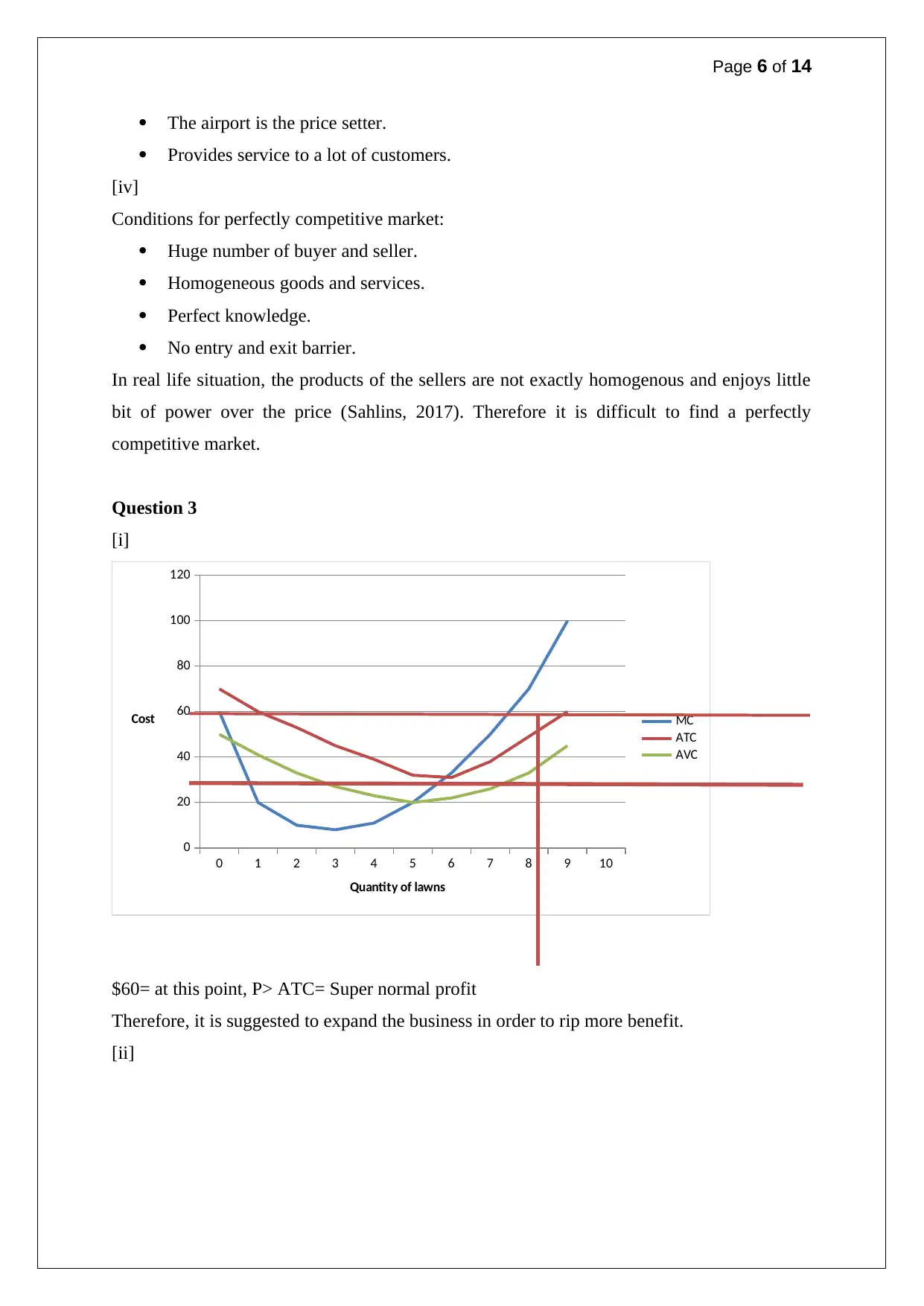
Page 6 of 14
The airport is the price setter.
Provides service to a lot of customers.
[iv]
Conditions for perfectly competitive market:
Huge number of buyer and seller.
Homogeneous goods and services.
Perfect knowledge.
No entry and exit barrier.
In real life situation, the products of the sellers are not exactly homogenous and enjoys little
bit of power over the price (Sahlins, 2017). Therefore it is difficult to find a perfectly
competitive market.
Question 3
[i]
0 1 2 3 4 5 6 7 8 9 10
0
20
40
60
80
100
120
MC
ATC
AVC
Quantity of lawns
Cost
$60= at this point, P> ATC= Super normal profit
Therefore, it is suggested to expand the business in order to rip more benefit.
[ii]
The airport is the price setter.
Provides service to a lot of customers.
[iv]
Conditions for perfectly competitive market:
Huge number of buyer and seller.
Homogeneous goods and services.
Perfect knowledge.
No entry and exit barrier.
In real life situation, the products of the sellers are not exactly homogenous and enjoys little
bit of power over the price (Sahlins, 2017). Therefore it is difficult to find a perfectly
competitive market.
Question 3
[i]
0 1 2 3 4 5 6 7 8 9 10
0
20
40
60
80
100
120
MC
ATC
AVC
Quantity of lawns
Cost
$60= at this point, P> ATC= Super normal profit
Therefore, it is suggested to expand the business in order to rip more benefit.
[ii]
⊘ This is a preview!⊘
Do you want full access?
Subscribe today to unlock all pages.

Trusted by 1+ million students worldwide
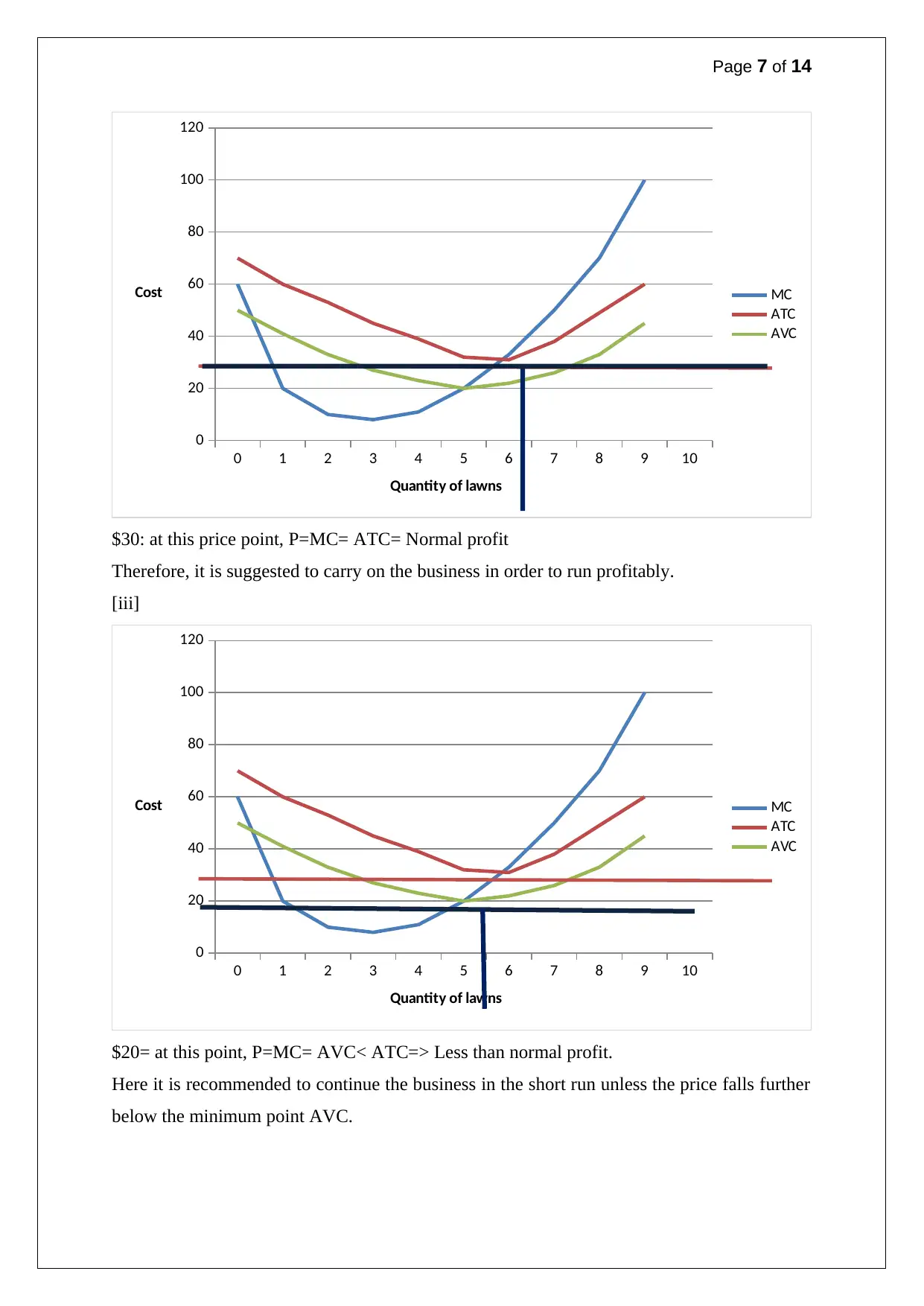
Page 7 of 14
0 1 2 3 4 5 6 7 8 9 10
0
20
40
60
80
100
120
MC
ATC
AVC
Quantity of lawns
Cost
$30: at this price point, P=MC= ATC= Normal profit
Therefore, it is suggested to carry on the business in order to run profitably.
[iii]
0 1 2 3 4 5 6 7 8 9 10
0
20
40
60
80
100
120
MC
ATC
AVC
Quantity of lawns
Cost
$20= at this point, P=MC= AVC< ATC=> Less than normal profit.
Here it is recommended to continue the business in the short run unless the price falls further
below the minimum point AVC.
0 1 2 3 4 5 6 7 8 9 10
0
20
40
60
80
100
120
MC
ATC
AVC
Quantity of lawns
Cost
$30: at this price point, P=MC= ATC= Normal profit
Therefore, it is suggested to carry on the business in order to run profitably.
[iii]
0 1 2 3 4 5 6 7 8 9 10
0
20
40
60
80
100
120
MC
ATC
AVC
Quantity of lawns
Cost
$20= at this point, P=MC= AVC< ATC=> Less than normal profit.
Here it is recommended to continue the business in the short run unless the price falls further
below the minimum point AVC.
Paraphrase This Document
Need a fresh take? Get an instant paraphrase of this document with our AI Paraphraser
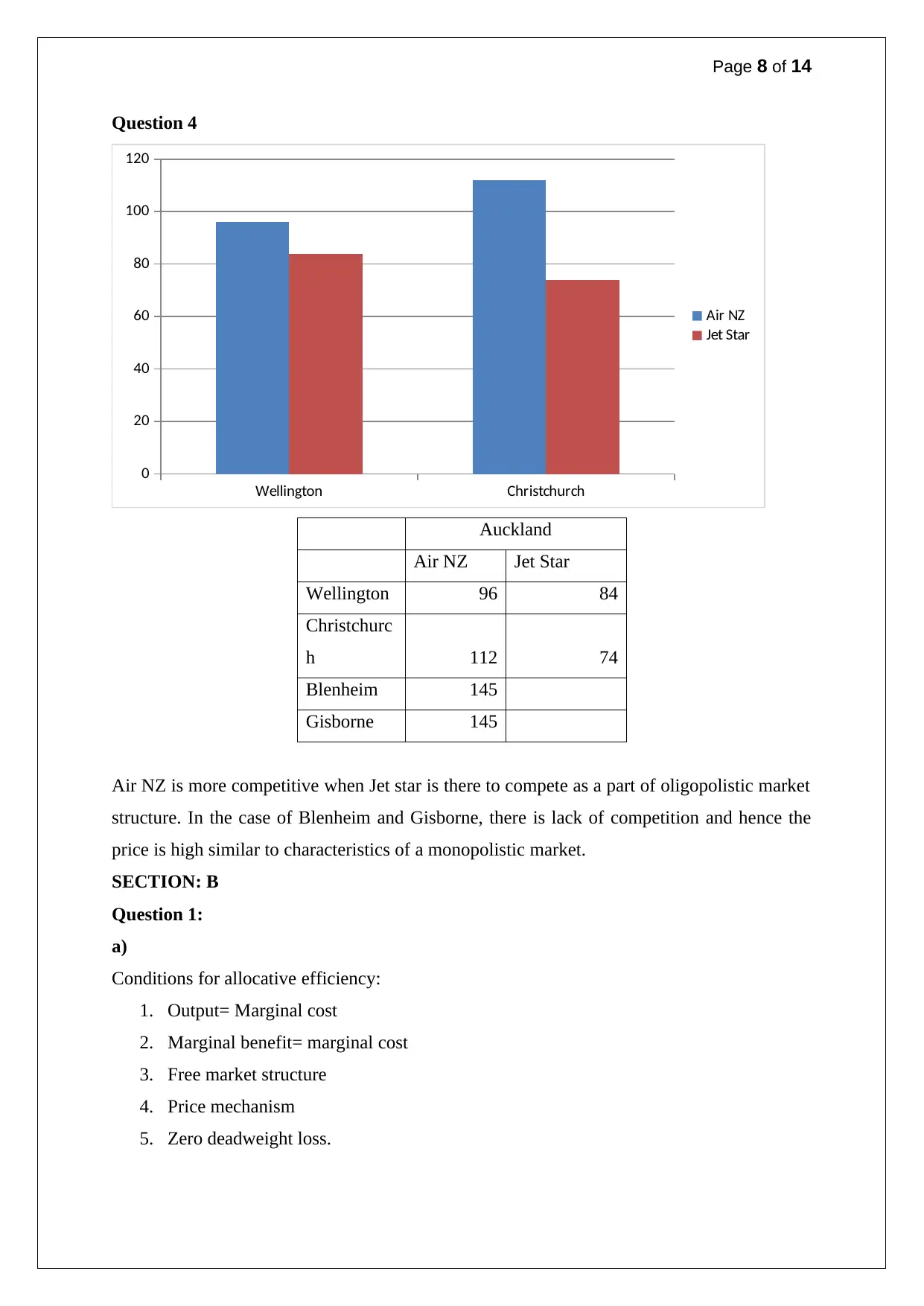
Page 8 of 14
Question 4
Wellington Christchurch
0
20
40
60
80
100
120
Air NZ
Jet Star
Auckland
Air NZ Jet Star
Wellington 96 84
Christchurc
h 112 74
Blenheim 145
Gisborne 145
Air NZ is more competitive when Jet star is there to compete as a part of oligopolistic market
structure. In the case of Blenheim and Gisborne, there is lack of competition and hence the
price is high similar to characteristics of a monopolistic market.
SECTION: B
Question 1:
a)
Conditions for allocative efficiency:
1. Output= Marginal cost
2. Marginal benefit= marginal cost
3. Free market structure
4. Price mechanism
5. Zero deadweight loss.
Question 4
Wellington Christchurch
0
20
40
60
80
100
120
Air NZ
Jet Star
Auckland
Air NZ Jet Star
Wellington 96 84
Christchurc
h 112 74
Blenheim 145
Gisborne 145
Air NZ is more competitive when Jet star is there to compete as a part of oligopolistic market
structure. In the case of Blenheim and Gisborne, there is lack of competition and hence the
price is high similar to characteristics of a monopolistic market.
SECTION: B
Question 1:
a)
Conditions for allocative efficiency:
1. Output= Marginal cost
2. Marginal benefit= marginal cost
3. Free market structure
4. Price mechanism
5. Zero deadweight loss.
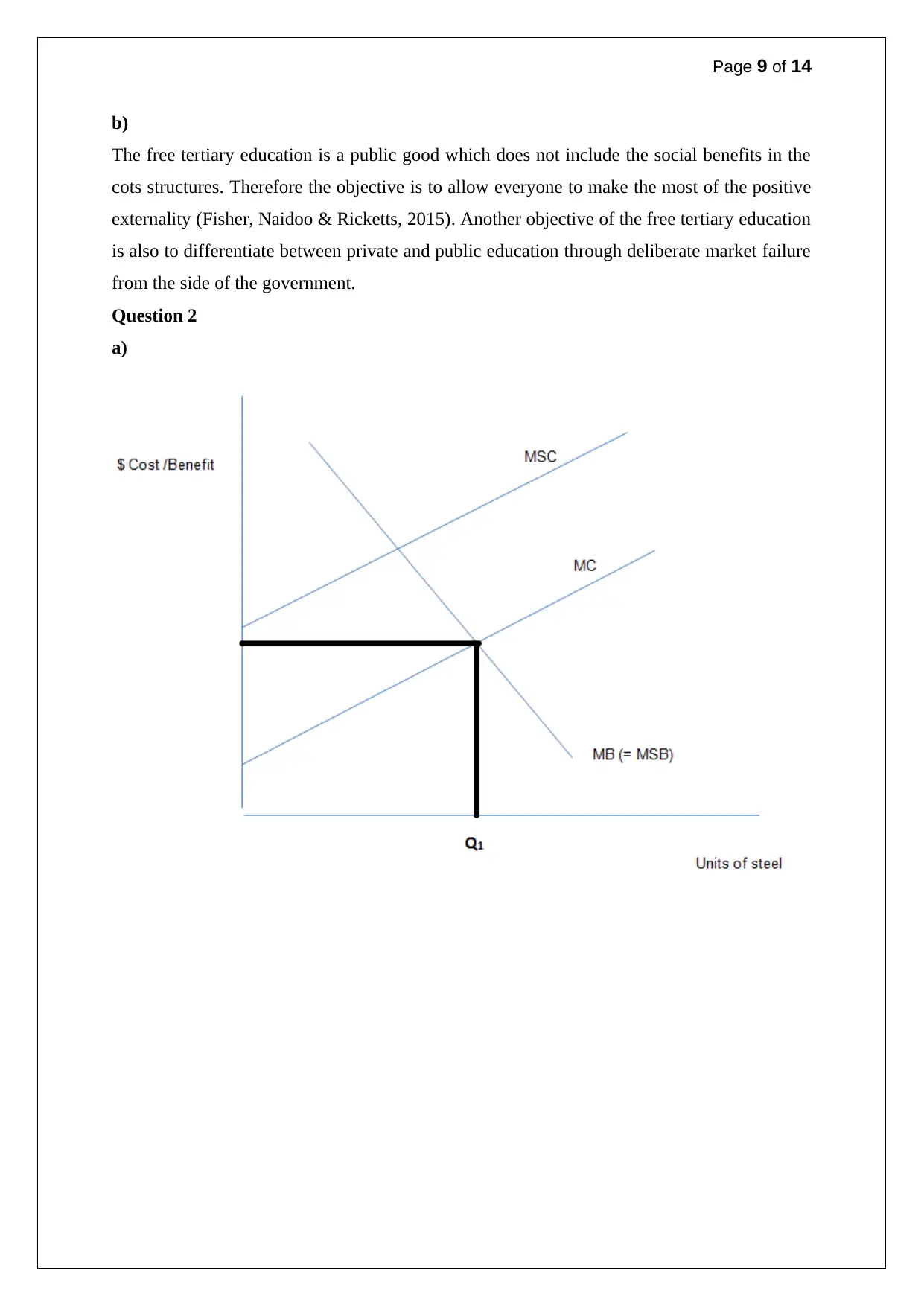
Page 9 of 14
b)
The free tertiary education is a public good which does not include the social benefits in the
cots structures. Therefore the objective is to allow everyone to make the most of the positive
externality (Fisher, Naidoo & Ricketts, 2015). Another objective of the free tertiary education
is also to differentiate between private and public education through deliberate market failure
from the side of the government.
Question 2
a)
b)
The free tertiary education is a public good which does not include the social benefits in the
cots structures. Therefore the objective is to allow everyone to make the most of the positive
externality (Fisher, Naidoo & Ricketts, 2015). Another objective of the free tertiary education
is also to differentiate between private and public education through deliberate market failure
from the side of the government.
Question 2
a)
⊘ This is a preview!⊘
Do you want full access?
Subscribe today to unlock all pages.

Trusted by 1+ million students worldwide
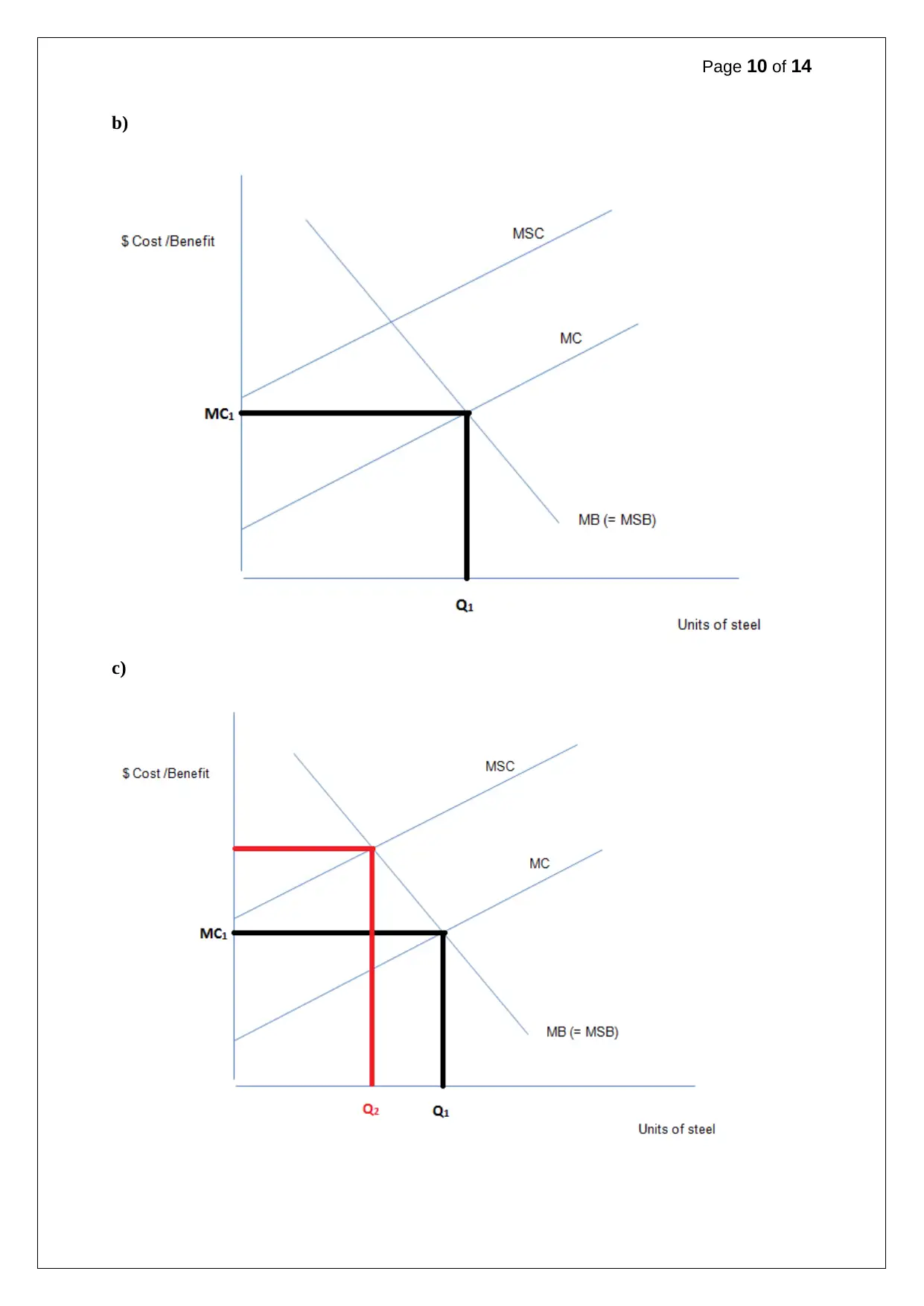
Page 10 of 14
b)
c)
b)
c)
Paraphrase This Document
Need a fresh take? Get an instant paraphrase of this document with our AI Paraphraser
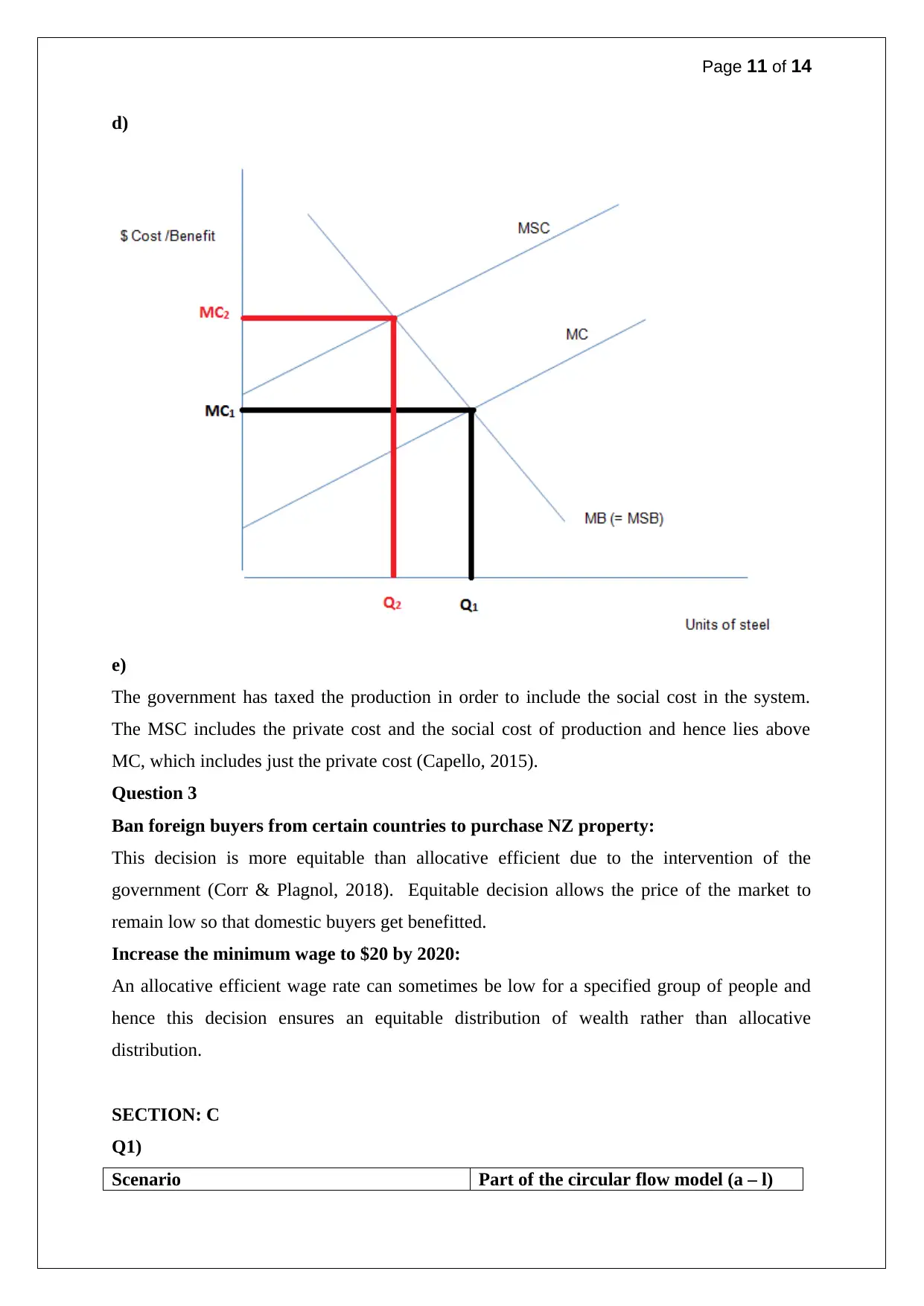
Page 11 of 14
d)
e)
The government has taxed the production in order to include the social cost in the system.
The MSC includes the private cost and the social cost of production and hence lies above
MC, which includes just the private cost (Capello, 2015).
Question 3
Ban foreign buyers from certain countries to purchase NZ property:
This decision is more equitable than allocative efficient due to the intervention of the
government (Corr & Plagnol, 2018). Equitable decision allows the price of the market to
remain low so that domestic buyers get benefitted.
Increase the minimum wage to $20 by 2020:
An allocative efficient wage rate can sometimes be low for a specified group of people and
hence this decision ensures an equitable distribution of wealth rather than allocative
distribution.
SECTION: C
Q1)
Scenario Part of the circular flow model (a – l)
d)
e)
The government has taxed the production in order to include the social cost in the system.
The MSC includes the private cost and the social cost of production and hence lies above
MC, which includes just the private cost (Capello, 2015).
Question 3
Ban foreign buyers from certain countries to purchase NZ property:
This decision is more equitable than allocative efficient due to the intervention of the
government (Corr & Plagnol, 2018). Equitable decision allows the price of the market to
remain low so that domestic buyers get benefitted.
Increase the minimum wage to $20 by 2020:
An allocative efficient wage rate can sometimes be low for a specified group of people and
hence this decision ensures an equitable distribution of wealth rather than allocative
distribution.
SECTION: C
Q1)
Scenario Part of the circular flow model (a – l)
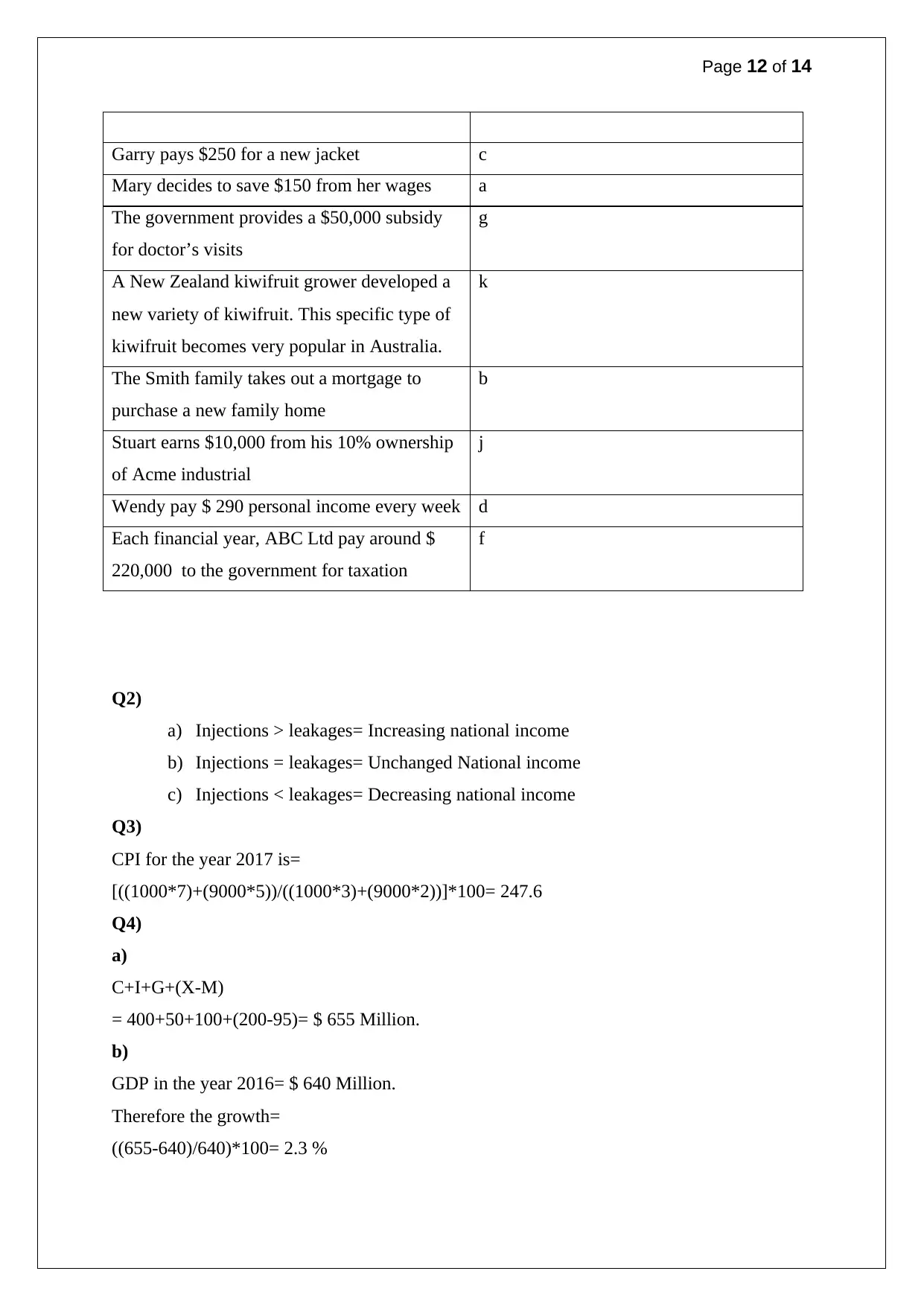
Page 12 of 14
Garry pays $250 for a new jacket c
Mary decides to save $150 from her wages a
The government provides a $50,000 subsidy
for doctor’s visits
g
A New Zealand kiwifruit grower developed a
new variety of kiwifruit. This specific type of
kiwifruit becomes very popular in Australia.
k
The Smith family takes out a mortgage to
purchase a new family home
b
Stuart earns $10,000 from his 10% ownership
of Acme industrial
j
Wendy pay $ 290 personal income every week d
Each financial year, ABC Ltd pay around $
220,000 to the government for taxation
f
Q2)
a) Injections > leakages= Increasing national income
b) Injections = leakages= Unchanged National income
c) Injections < leakages= Decreasing national income
Q3)
CPI for the year 2017 is=
[((1000*7)+(9000*5))/((1000*3)+(9000*2))]*100= 247.6
Q4)
a)
C+I+G+(X-M)
= 400+50+100+(200-95)= $ 655 Million.
b)
GDP in the year 2016= $ 640 Million.
Therefore the growth=
((655-640)/640)*100= 2.3 %
Garry pays $250 for a new jacket c
Mary decides to save $150 from her wages a
The government provides a $50,000 subsidy
for doctor’s visits
g
A New Zealand kiwifruit grower developed a
new variety of kiwifruit. This specific type of
kiwifruit becomes very popular in Australia.
k
The Smith family takes out a mortgage to
purchase a new family home
b
Stuart earns $10,000 from his 10% ownership
of Acme industrial
j
Wendy pay $ 290 personal income every week d
Each financial year, ABC Ltd pay around $
220,000 to the government for taxation
f
Q2)
a) Injections > leakages= Increasing national income
b) Injections = leakages= Unchanged National income
c) Injections < leakages= Decreasing national income
Q3)
CPI for the year 2017 is=
[((1000*7)+(9000*5))/((1000*3)+(9000*2))]*100= 247.6
Q4)
a)
C+I+G+(X-M)
= 400+50+100+(200-95)= $ 655 Million.
b)
GDP in the year 2016= $ 640 Million.
Therefore the growth=
((655-640)/640)*100= 2.3 %
⊘ This is a preview!⊘
Do you want full access?
Subscribe today to unlock all pages.

Trusted by 1+ million students worldwide
1 out of 14
Related Documents
Your All-in-One AI-Powered Toolkit for Academic Success.
+13062052269
info@desklib.com
Available 24*7 on WhatsApp / Email
![[object Object]](/_next/static/media/star-bottom.7253800d.svg)
Unlock your academic potential
Copyright © 2020–2025 A2Z Services. All Rights Reserved. Developed and managed by ZUCOL.





